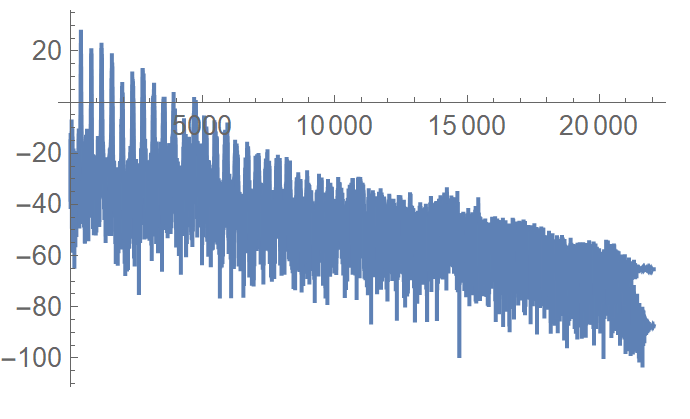Consider some sound:
ViolinNote = Sound[SoundNote["G", 1, "Violin"]]
We may plot the periodogram:
Periodogram[ViolinNote]
The y-axis is the amplitude in dB, while the x-axis is the frequency in Hz. My question is about the meaning of 0 dB: does it mean that everything below 0 dB is not audible, and if yes then how does Mathematica extract it?
I.e., the definition the amplitude in dB, according to the reference, is
$$ \text{Amplitude (dB)} = 10\log\left( \frac{P_{2}}{P_{1}}\right) $$ where $P_{2}$ is the power (just the Fourier coefficient squared) of the given tone $\omega_{2}$. What Mathematica uses for $P_{1}$, i.e., how does Mathematica define it? I have not found the corresponding information in the documentation.
Clearly, 0 dB is not the audibility limit: one may apply the highpass filter
ViolinNoteFiltered = HighpassFilter[ViolinNote, {Quantity[5000, "Hertz"]}, 2000]
where 5000 Hz is the frequency above which the amplitude is below 0 dB, and observe that the sound is still audible.





My question is about the meaning of 0 dB: does it mean that everything below 0 dB is not audibleYes. this is from the internetThe intensity of energy that these sound waves produce is measured in units called decibels (dB). The lowest hearing decibel level is 0 dB, which indicates nearly total silence and is the softest sound that the human ear can hear. Generally speaking, the louder the sound, the higher the decibel number.$\endgroup$p1 = Periodogram[ViolinNote, PlotStyle -> Red]p2 = Periodogram[AudioAmplify[ViolinNote, 1/10]]and finallyShow[p1, p2]. It clearly shows that 0dB on a periodogram has a different referencing and is not related to the way the term is used in the audio business. $\endgroup$